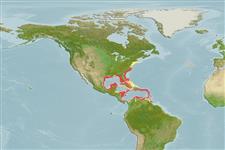Environment: milieu / climate zone / depth range / distribution range
ນິເວດວິທະຍາ
ສັດທະເລ; ນ້ຳກ່ອຍ ກ່ຽວກັນຫີນ; ປາທີ່ມີການເຄື່ອນຍ້າຍໃນສະເພາະມາະຫາສະມຸດ (Ref. 51243); ລະດັບຄວາມເລິກ 30 - 100 m (Ref. 5222), usually 30 - 100 m (Ref. 5222). Subtropical; 41°N - 8°N, 98°W - 25°W (Ref. 5222)
Western Central Atlantic: Gulf of Mexico and east coast of US from North Carolina to Key West and along the southern shore of the Caribbean Sea. Juveniles are occasionally found as far north as Massachusetts.
Length at first maturity / ຂະໜາດ / ນ້ຳໜັກ / Age
Maturity: Lm 33.2 range ? - ? cm
Max length : 107 cm TL ຕົວຜູ້/ບໍ່ມີເພດ; (Ref. 89707); common length : 30.0 cm TL ຕົວຜູ້/ບໍ່ມີເພດ; (Ref. 3708); ນ້ຳໜັກສູງສຸດທີ່ເຄຍຈັດພີມມາ: 14.2 kg (Ref. 40637); ອາຍຸສູງສຸດທີ່ເຄຍລາຍງານມາ: 21 ປີ (Ref. 6846)
ຄີ (ໜາມ)ແຂງຢູ່ຫຼັງປາ (ທັງໝົດ) : 11; ຄີຫຼັງຂອງປາ (ຄີອ່ອນ) (ທັງໝົດ) : 16 - 18; ຄີ(ໜາມ) ແຂງຢູ່ຄີກົ້ນປາ
ກຸ່ມປາກະດູກແຂງ
ຄວາມຖີ່ຂອງກຸ່ມຖ່າຍທອດພັນ
ປາທີ່ມີການເຄື່ອນຍ້າຍຈາກທະເລໄປຫານ້ຳຈືດ ແລະນ້ຳຈືດຫາທະເລ
ປາທີ່ມີການເຄື່ອນຍ້າຍຈາກທະເລແລະໄປໄຂ່ຢູ່ນ້ຳຈືດ
ຄີກົ້ນຂອງປາ
ສັດທີ່ມີກະດູກສັນຫັຼງ
ການຖ່າຍທອດທາງກຳມະພັນຈາກພໍ່ແມ່ຫາລູກ: 3; ຄີກົ້ນຂອງປາ: 10 - 12. Distinguished by the following characteristics: four color patterns, first is brown phase with head and body pale brown covered with small reddish brown spots that extend onto median fins, second is cat's paw phase with pale brown body color with dorsolateral parts of body having several clusters of dark brown spots resembling the paw print of a cat, third is with large adults with grey-head phase with the rear two-thirds of the body dark, head and body anterior to the 6th dorsal-fin spine in silvery grey with dark reticulations and fourth is bicoloured phase with pale brown anteriorly and abruptly dark chocolate brown posteriorly; depth of body contained 3.0-3.4 times in SL; head length 2.6-3.0 times in SL; convex interorbital area; angular preopercle, angle with distinct bony lobe; serrate interopercle and subopercle; posterior nostrils of adults 2-4 times larger than anterior ones (Ref. 89707).
Found over ledges and high-relief rocky bottoms in the eastern Gulf of Mexico; at low-profile bottoms at depths of 30 to 100 m in North Carolina; this species was the most abundant grouper in areas of living Oculina coral formations at depths of 70 to 100 m off the east coast of Florida. This species apparently moved inshore when bottom temperature fell below 8.6°C. Juveniles found in shallow water at jetties and in mangrove areas.
Life cycle and mating behavior
ການຈະເລີນເຕັມໄວ | ການສືບພັນ | ການວາງໄຂ່ | ໄຂ່ | ຄວາມດົກຂອງໄຂ່ປາ | ຕົວອ່ອນ
Heemstra, P.C. and J.E. Randall, 1993. FAO Species Catalogue. Vol. 16. Groupers of the world (family Serranidae, subfamily Epinephelinae). An annotated and illustrated catalogue of the grouper, rockcod, hind, coral grouper and lyretail species known to date. Rome: FAO. FAO Fish. Synop. 125(16):382 p. (Ref. 5222)
IUCN Red List Status (Ref. 130435: Version 2024-1)
Threat to humans
Harmless
Human uses
ການປະມົງ: ທີ່ມີການຄ້າສູງ; ຊະນິດປາທີ່ຖືກນຳໃຊ້ເຂົ້າໃນການຫາເພື່ອເປັນເກມກິລາ: ແມ່ນ
ເຄື່ອງມື
Special reports
Download XML
ແຫຼ່ງອີນເຕີເນັດ
Estimates based on models
Preferred temperature (Ref.
123201): 20.7 - 27.5, mean 24.4 °C (based on 130 cells).
Phylogenetic diversity index (Ref.
82804): PD
50 = 0.5000 [Uniqueness, from 0.5 = low to 2.0 = high].
Bayesian length-weight: a=0.00933 (0.00426 - 0.02047), b=3.05 (2.88 - 3.22), in cm total length, based on LWR estimates for this Genus-body shape (Ref.
93245).
ຊັ້ນເຂດຮ້ອນ (Ref.
69278): 4.5 ±0.0 se; based on diet studies.
ຄວາມຢືດຢຸ່ນ (Ref.
120179): ຕຳ່, ປະຊາກອນຕຳ່ສຸດທີ່ໃຊ້ເວລາສອງເທົ່າ 4.5 - 14 ປີ (K=0.09-0.17; tmax=21).
Fishing Vulnerability (Ref.
59153): High to very high vulnerability (69 of 100).
Climate Vulnerability (Ref.
125649): Moderate to high vulnerability (52 of 100).
Nutrients (Ref.
124155): Calcium = 11.7 [6.1, 26.2] mg/100g; Iron = 0.425 [0.208, 0.783] mg/100g; Protein = 19.6 [17.7, 21.3] %; Omega3 = 0.224 [0.128, 0.407] g/100g; Selenium = 18.8 [9.1, 37.6] μg/100g; VitaminA = 67 [18, 279] μg/100g; Zinc = 0.582 [0.373, 0.907] mg/100g (wet weight);
